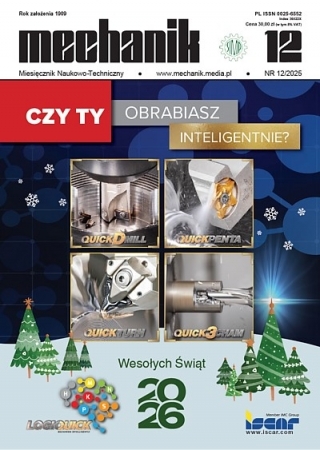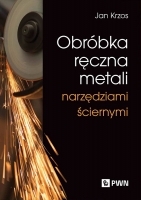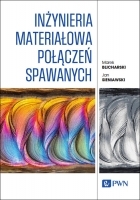Monitorowanie wybranych wielkości procesowych w szlifowaniu CFG
Monitoring of selected process variables during the CFG grinding
Mechanik nr 12/2015 - Wersje autorskie artykułów VIII Seminarium zadań badawczych
STRESZCZENIE: Proces szlifowania stosuje się często jako obróbkę zgrubną dla materiałów trudno skrawalnych (proces CFG). Jednocześnie jego efekt jest zależny od trudnych do zmierzenia w trybie on-line parametrów. Z uwagi na znaczny koszt elementów obrabianych istotnym zagadnieniem jest problem monitorowania tego procesu. Zaprezentowane badania na mają celu określenie możliwości wykorzystania do tego celu wybranych sygnałów pomiarowych wielkości procesowych.
W przeprowadzonych badaniach wykorzystano układy pomiarowe emisji akustycznej, prądu wrzeciona ściernicy, drgań oraz składowych stycznej i normalnej siły szlifowania. Następnie zostały one ocenione pod kątem możliwości wykorzystania w układzie monitorowania procesu. Efekt końcowy procesu określano poprzez pomiary parametrów chropowatości oraz brak uszkodzeń termicznych powierzchni.
SŁOWA KLUCZOWE: szlifowanie, monitorowanie, CFG
ABSTRACT: The grinding process is often used as a roughing operation for materials difficult to machine (the process CFG). Simultaneously the end result is dependent on a large number of different, difficult to measure on-line parameters. Because of the significant cost of workpieces significant issue becomes the problem of monitoring this process. The presented research are to determine capabilities of using to that selected process variables of measuring signals. In this the acoustic emission, current of grinding spindle, vibrations and grinding force signal were used. They were then evaluated for capabilities to use in the system for monitoring the CFG process. The end results of the process were determined by measuring the roughness parameters and the lack of thermal damage on the surface.
KEYWORDS: grinding, monitoring, CFG
BIBLIOGRAFIA / BIBLIOGRAPHY:
- Nesluam M., “Grinding of Ni-based alloys with grinding wheels of high porosity”. Advances in Production Engineering & Menagement, 4(2009)1-2, p.29-36.
- Liao Y.S., Lin H.M., Wang J.H., “Behaviors of end milling Inconel 718 superalloy by cemented carbide tools.” Journal of Materials Processing Technology, 20I(2008), p.460–465.
- Wenfeng D., Jiuhua X., Zhenzhen C., Honghua S., Yucan F., “Grindability and Surface Integrity of Cast Nickel-based Superalloy in Creep Feed Grinding with Brazed CBN.” Abrasive Wheels, Chinese Journal of Aeronautics, 23(2010), p.501-510.
- Xu X., Yu Y., Huang H., “Mechanisms of abrasive wear in the grinding of titanium (TC4) and nickel (K417) alloys.” Wear 255 (2003), p.1421–1426.
- Chen X., Griffin J., Liu Q., “Mechanical and thermal behaviors of grinding acoustic emission.” Int. Journal of Manufacturing Technology and Management, 2006.
- Yang Y., Lin J., Xu S.,“Surface Grinding Machine Stability Characteristics Limited Prediction.” Mechanical Engineering Research; Vol. 2, No. 2, ISSN 1927-0607, 2012.
- Gołąbczak A., Święcik R., Galant M. ,„Modelowanie i weryfikacja doświadczalna temperatury w procesie szlifowania AEDG stopu tytanu." Mechanik. Nr 8-9, (2013). s.136-143/701
- Németh Š., Neslušan M.,“Vibration in grinding operations”. 7th International Multidisciplinary Conference Baia Mare, Romania, May 17-18, 2007.
- Gradisek J., Baus A., Govekar E., Klocke F., Grabec I. “Automatic chatter detection in grinding.” International Journal of Machine Tools & Manufacture 43, 1397–1403, 2003.
- Zh L., Payre G., “Stability of Doubly Regenerative Cylindrical Grinding Process.” Journal of Sound and Vibration, 310 (3–5), 950–962, 2007.
- Kabin S. K., “Dynamic Modeling of Chatter Vibration in Cylindrical Plunge Grinding Process.” Innovative Systems Design and Engineering, ISSN 2222-1727, Vol 2, No 4, 2011.
- Sutowski P., Plichta S., “An investigation of the grinding wheel wear with the use of root-mean-square value of acoustic emission.” Archives of Civil and Mechanical Engineering, vol VI, 2006.




















